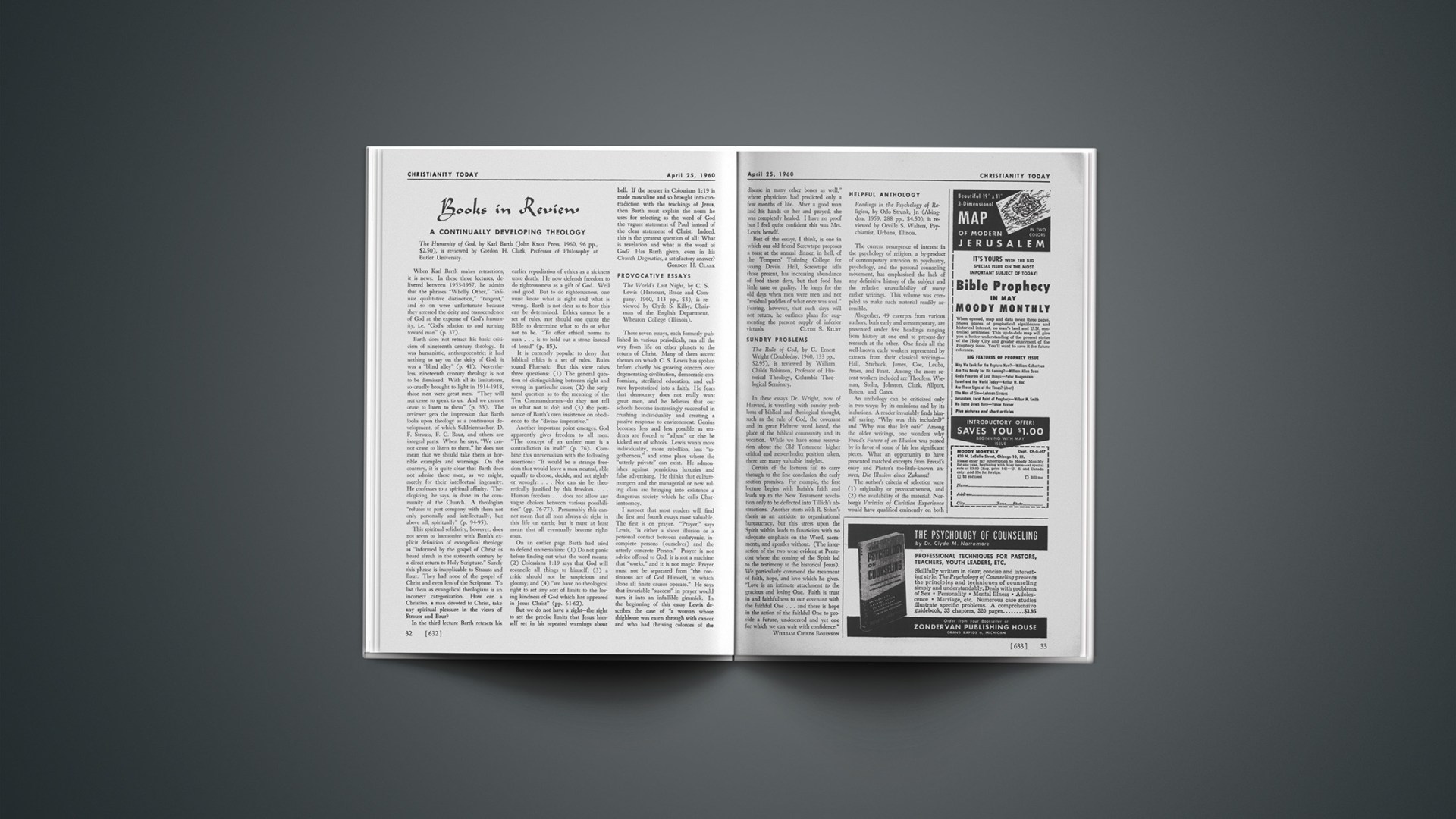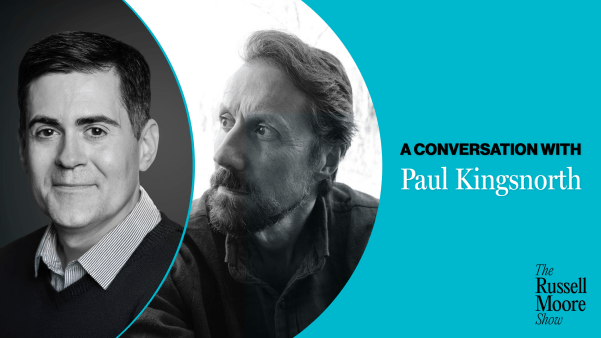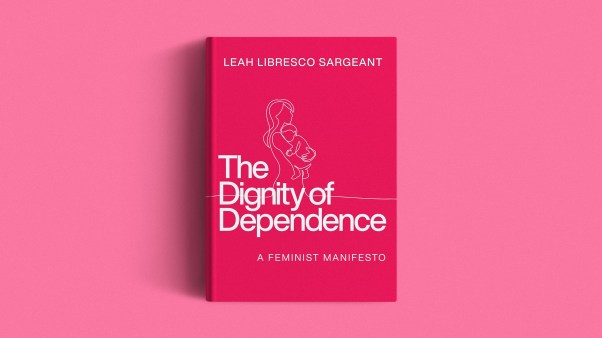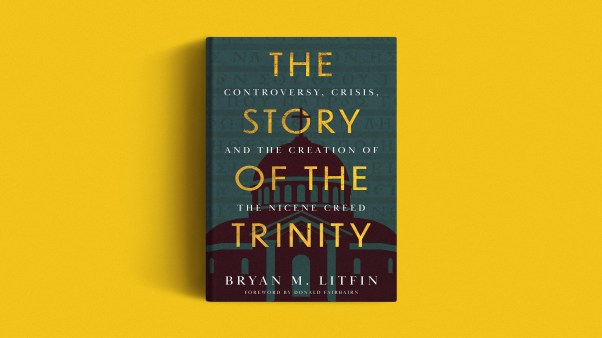A Continually Developing Theology
The Humanity of God, by Karl Barth (John Knox Press, 1960, 96 pp., $2.50), is reviewed by Gordon H. Clark, Professor of Philosophy at Butler University.
When Karl Barth makes retractions, it is news. In these three lectures, delivered between 1953–1957, he admits that the phrases “Wholly Other,” “infinite qualitative distinction,” “tangent,” and so on were unfortunate because they stressed the deity and transcendence of God at the expense of God’s humanity, i.e. “God’s relation to and turning toward man” (p. 37).
Barth does not retract his basic criticism of nineteenth century theology. It was humanistic, anthropocentric; it had nothing to say on the deity of God; it was a “blind alley” (p. 41). Nevertheless, nineteenth century theology is not to be dismissed. With all its limitations, so cruelly brought to light in 1914–1918, those men were great men. “They will not cease to speak to us. And we cannot cease to listen to them” (p. 33). The reviewer gets the impression that Barth looks upon theology as a continuous development, of which Schleiermacher, D. F. Strauss, F. C. Baur, and others are integral parts. When he says, “We cannot cease to listen to them,” he does not mean that we should take them as horrible examples and warnings. On the contrary, it is quite clear that Barth does not admire these men, as we might, merely for their intellectual ingenuity. He confesses to a spiritual affinity. Theologizing, he says, is done in the community of the Church. A theologian “refuses to part company with them not only personally and intellectually, but above all, spiritually” (p. 94–95).
This spiritual solidarity, however, does not seem to harmonize with Barth’s explicit definition of evangelical theology as “informed by the gospel of Christ as heard afresh in the sixteenth century by a direct return to Holy Scripture.” Surely this phrase is inapplicable to Strauss and Baur. They had none of the gospel of Christ and even less of the Scripture. To list them as evangelical theologians is an incorrect categorization. How can a Christian, a man devoted to Christ, take any spiritual pleasure in the views of Strauss and Baur?
In the third lecture Barth retracts his earlier repudiation of ethics as a sickness unto death. He now defends freedom to do righteousness as a gift of God. Well and good. But to do righteousness, one must know what is right and what is wrong. Barth is not clear as to how this can be determined. Ethics cannot be a set of rules, nor should one quote the Bible to determine what to do or what not to be. “To offer ethical norms to man … is to hold out a stone instead of bread” (p. 85).
It is currently popular to deny that biblical ethics is a set of rules. Rules sound Pharisaic. But this view raises three questions: (1) The general question of distinguishing between right and wrong in particular cases; (2) the scriptural question as to the meaning of the Ten Commandments—do they not tell us what not to do?; and (3) the pertinence of Barth’s own insistence on obedience to the “divine imperative.”
Another important point emerges. God apparently gives freedom to all men. “The concept of an unfree man is a contradiction in itself” (p. 76). Combine this universalism with the following assertions: “It would be a strange freedom that would leave a man neutral, able equally to choose, decide, and act rightly or wrongly.… Nor can sin be theoretically justified by this freedom.… Human freedom … does not allow any vague choices between various possibilities” (pp. 76–77). Presumably this cannot mean that all men always do right in this life on earth; but it must at least mean that all eventually become righteous.
On an earlier page Barth had tried to defend universalism: (1) Do not panic before finding out what the word means; (2) Colossians 1:19 says that God will reconcile all things to himself; (3) a critic should not be suspicious and gloomy; and (4) “we have no theological right to set any sort of limits to the loving kindness of God which has appeared in Jesus Christ” (pp. 61–62).
But we do not have a right—the right to set the precise limits that Jesus himself set in his repeated warnings about hell. If the neuter in Colossians 1:19 is made masculine and so brought into contradiction with the teachings of Jesus, then Barth must explain the norm he uses for selecting as the word of God the vaguer statement of Paul instead of the clear statement of Christ. Indeed, this is the greatest question of all: What is revelation and what is the word of God? Has Barth given, even in his Church Dogmatics, a satisfactory answer?
GORDON H. CLARK
Provocative Essays
The World’s Last Night, by C. S. Lewis (Harcourt, Brace and Company, 1960, 113 pp., $3), is reviewed by Clyde S. Kilby, Chairman of the English Department, Wheaton College (Illinois).
These seven essays, each formerly published in various periodicals, run all the way from life on other planets to the return of Christ. Many of them accent themes on which C. S. Lewis has spoken before, chiefly his growing concern over degenerating civilization, democratic conformism, sterilized education, and culture hypostatized into a faith. He fears that democracy does not really want great men, and he believes that our schools become increasingly successful in crushing individuality and creating a passive response to environment. Genius becomes less and less possible as students are forced to “adjust” or else be kicked out of schools. Lewis wants more individuality, more rebellion, less “togetherness,” and some place where the “utterly private” can exist. He admonishes against pernicious luxuries and false advertising. He thinks that culture-mongers and the managerial or new ruling class are bringing into existence a dangerous society which he calls Charientocracy.
I suspect that most readers will find the first and fourth essays most valuable. The first is on prayer. “Prayer,” says Lewis, “is either a sheer illusion or a personal contact between embryonic, incomplete persons (ourselves) and the utterly concrete Person.” Prayer is not advice offered to God, it is not a machine that “works,” and it is not magic. Prayer must not be separated from “the continuous act of God Himself, in which alone all finite causes operate.” He says that invariable “success” in prayer would turn it into an infallible gimmick. In the beginning of this essay Lewis describes the case of “a woman whose thighbone was eaten through with cancer and who had thriving colonies of the disease in many other bones as well,” where physicians had predicted only a few months of life. After a good man laid his hands on her and prayed, she was completely healed. I have no proof but I feel quite confident this was Mrs. Lewis herself.
Best of the essays, I think, is one in which our old friend Screwtape proposes a toast at the annual dinner, in hell, of the Tempters’ Training College for young Devils. Hell, Screwtape tells those present, has increasing abundance of food these days, but that food has little taste or quality. He longs for the old days when men were men and not “residual puddles of what once was soul.” Fearing, however, that such days wall not return, he outlines plans for augmenting the present supply of inferior victuals.
CLYDE S. KILBY
Sundry Problems
The Rule of God, by G. Ernest Wright (Doubleday, 1960, 133 pp., $2.95), is reviewed by William Childs Robinson, Professor of Historical Theology, Columbia Theological Seminary.
In these essays Dr. Wright, now of Harvard, is wrestling with sundry problems of biblical and theological thought, such as the rule of God, the covenant and its great Hebrew word hesed, the place of the biblical community and its vocation. While we have some reservation about the Old Testament higher critical and neo-orthodox position taken, there are many valuable insights.
Certain of the lectures fail to carry through to the fine conclusion the early section promises. For example, the first lecture begins with Isaiah’s faith and leads up to the New Testament revelation only to be deflected into Tillich’s abstractions. Another starts with R. Sohm’s thesis as an antidote to organizational bureaucracy, but this stress upon the Spirit within leads to fanaticism with no adequate emphasis on the Word, sacraments, and apostles without. (The interaction of the two were evident at Pentecost where the coming of the Spirit led to the testimony to the historical Jesus). We particularly commend the treatment of faith, hope, and love which he gives. “Love is an intimate attachment to the gracious and loving One. Faith is trust in and faithfulness to our covenant with the faithful One … and there is hope in the action of the faithful One to provide a future, undeserved and yet one for which we can wait with confidence.”
WILLIAM CHILDS ROBINSON
Helpful Anthology
Readings in the Psychology of Religion, by Orlo Strunk, Jr. (Abingdon, 1959, 288 pp., $4.50), is reviewed by Orville S. Walters, Psychiatrist, Urbana, Illinois.
The current resurgence of interest in the psychology of religion, a by-product of contemporary attention to psychiatry, psychology, and the pastoral counseling movement, has emphasized the lack of any definitive history of the subject and the relative unavailability of many earlier writings. This volume was compiled to make such material readily accessible.
Altogether, 49 excerpts from various authors, both early and contemporary, are presented under five headings ranging from history at one end to present-day research at the other. One finds all the well-known early workers represented by extracts from their classical writings—Hall, Starbuck, James, Coe, Leuba, Ames, and Pratt. Among the more recent workers included are Thouless, Wieman, Stoltz, Johnson, Clark, Allport, Boisen, and Oates.
An anthology can be criticized only in two ways: by its omissions and by its inclusions. A reader invariably finds himself saying, “Why was this included?” and “Why was that left out?” Among the older writings, one wonders why Freud’s Future of an Illusion was passed by in favor of some of his less significant pieces. What an opportunity to have presented matched excerpts from Freud’s essay and Pfister’s too-little-known answer, Die Illusion einer Zukunst!
The author’s criteria of selection were (1) originality or provocativeness, and (2) the availability of the material. Norborg’s Varieties of Christian Experience would have qualified eminently on both counts. Recent selections might well have included pieces from the Roman Catholic symposia, The Human Person and Faith, Reason and Modern Psychiatry.
Disagree as one may with the editor’s choices, the volume is composed largely of classic writings in the field, and will find wide acceptance for making these scattered pieces easily available.
ORVILLE S. WALTERS
John Knox Story
Tempest over Scotland, by Norman E. Nygaard (Zondervan, 1960, 183 pp., $2.50), is reviewed by W. Stanford Reid, Associate Professor of History, McGill University, Montreal.
This work is a fictionalized biography of John Knox, and the reviewer must confess to reading it with a good deal of prejudice. As a historian he has always disliked this type of work, and his opinion has not been changed by this example. The rather free handling of historical facts, the lack of real knowledge of Scottish history and geography, what can only be described as the “corny” attempts at a little Scottish accent and the stilted character of much of the dialogue, hardly make the book attractive. On the other hand, the author has obviously read Knox’s writings and does give quite useful summaries of his First Blast and other works. It is a pity that he did not write a straight biography of Knox, rather than an account which seems to miss the mark.
W. STANFORD REID
Practical Answers
Questions People Ask About Religion, by W. E. Sangster (Abingdon, 1959, 142 pp., $2.25), is reviewed by Howard F. Shipps, Professor of Church History at Asbury Theological Seminary.
Dr. Sangster is speaking to the present generation as one of the commanding voices of English Protestantism. Through pulpit and press on both sides of the Atlantic he has directed the attention of multitudes to the reasonableness and the validity of the Christian Gospel. This most recent volume has summarized much of the teaching of his great public ministry.
The book becomes a kind of miniature systematic theology and serves a two-fold purpose: (1) It enables the believer to become more firmly established in his understanding of the Scriptures and in his Christian convictions, and (2) It presents to the mind of the unbeliever the reasonableness of the Word of God and of the Christian position. One hundred questions typical of those which are being asked by the average person are presented for brief discussion and positive answer. These are grouped in eight major sections as follows: (1) Religion in General, (2) Jesus Christ, (3) The Bible, CO Prayer, (5) Providence, (6) The Church, (7) Miscellaneous, (8) What Could Christ Do?
One early insight of the first section is the affirmation that “there are four chief ways to conviction in religion: the way of authority, the way of intuition, the way of reason, and the way of experience.” Again the author indicates that it is only the man of faith who in the time of adversity can speak a sure word about God. Further insights on the section concerning Christ include such statements as these: “As far as humanity can disclose deity, he (Christ) revealed the life of God to men; part of his mission on earth was to show men and women that death is not a blind alley but a highway to life, and he came back from the dead to prove it; only at the Cross can we learn what God is like.” Such observations are typical of this book throughout. It will be of much practical benefit and spiritual blessing to readers. Dr. Sangster concludes with a brief epilogue or the one hundredth question, “So What?” In answering this question he suggests that there are but three ways open to each person as he is confronted with the Christian revelation, namely, materialism, agnosticism, or faith.
HOWARD F. SHIPPS
Devotional Commentary
Ephesians: Pattern for Christian Living, by Ray Summers (Broadman Press, 1960, 152 pp., $3), is reviewed by Fred L. Fisher, Professor of New Testament Interpretation, Golden Gate Baptist Theological Seminary.
Do you need help in understanding Ephesians? This book has it for preacher and layman alike. Not scintillating rhetoric, not scholarly discussion, not thorough exegesis but guidance in understanding is offered. The writer, for many years a teacher, writer, and preacher of note among Southern Baptists, is now Professor at Southern Baptist Seminary. He uses the rich resources of his experience to interpret the religious message of Ephesians which he views as a pattern for Christian living. This is a devotional commentary; it ignores many problems the scholar is concerned about; yet one will be a better interpreter of Ephesians for having read it.
FRED L. FISHER
Biblical Theology
Biblical Theology of the New Testament, by Charles Caldwell Ryrie (Moody Press, 1959, 384 pp., $5), is reviewed by M. Eugene Osterhaven, Professor of Systematic Theology, Western Theological Seminary.
An encouraging phenomenon in today’s world of biblico-theological study is the large number of works coming from the press with appreciation for the distinctive character of the Christian message. This book is one of them. It is a work in biblical theology described as a “combination which is partly historical, partly exegetical, partly critical, partly theological, and thereby totally distinctive.” It is interested in why something was written as well as what was written; it examines the procedures and presuppositions of Scripture as well as the product. Noting the confusion of thought regarding definition, the author avers that it is “that branch of theological science which deals systematically with the historically conditioned progress of the self-revelation of God as deposited in the Bible” (p. 12).
The writer sees biblical theology building on an apologetic which “has confirmed, among other things, the case for theism, supernatural miracles, and verbal, plenary inspiration of the Scriptures” (p. 15). Although a minor point in the book, this position, championed by Warfield, for whom this reviewer usually has high admiration, is open to serious objection. Apologetics does not lay the foundation and build the first floor of the house, at least not in Reformation theology.
The author’s method is to seek out the outstanding areas of the thinking of a writer, or the distinctive witness of revelation in a given period. A commendable emphasis is that “theological substructure is just as valid proof of any doctrine as explicit statements” (p. 22).
Except for the author’s premillennialism, his extremely weak arguments for transferring the Sermon on the Mount (in its main emphasis) to the Kingdom age (pp. 79 ff.), and his position on baptism which makes him feel it worth his while to state that “there were sufficient pools in Jerusalem to permit even the immersion of 3,000 converts on the day of Pentecost” (p. 118), this reviewer finds himself in substantial agreement with the author’s evangelical positions. Our criticism of the book is its oversimplification of important problems. Its clear outline may serve to assist some, but it cannot be compared in depth of scholarship or thoroughness of treatment with several other contemporary works in the same field. The author seeks to offer an apology for the evangelical position over against the “liberals,” a term frequently employed, but something more substantial than this work is needed.
In closing we note that it is questionable whether one ought to make the virgin birth of our Lord, as important as that doctrine is, a condition sine qua non for salvation (p. 42), or whether one can build a convincing case that Matthew gives a divinely inspired order of events on the basis of which theology can be constructed.
M. EUGENE OSTERHAVEN
Broad And Eclectic
Religious Education, a Comprehensive Survey, edited by Marvin J. Taylor (Abingdon, 1960, 446 pp., $6.50), is reviewed by Ronald C. Doll, Professor of Education, New York University.
For this reviewer, who is an evangelical and a generalist in educational methodology and curriculum, one purpose of Christian education is to make St. Paul more real than Kookie, and to bring the miracles of Pentecost closer to children’s consciousness than the exploits of Rocky Jones, Space Ranger. Marvin Taylor’s comprehensive, almost encyclopedic compilation serves, in its 37 close-packed chapters, many more purposes than this. Dr. Taylor, a former director of religious education and now a specialist in religious education at the University of Pittsburgh, has viewed his specialty broadly and eclectically in combining within a single volume material prepared by 40 authors whose interests range from theological abstraction to the practicalities of group leadership and audio-visual instruction.
Anyone who is both broadly and intensely interested in religious education has much to gain from the ideas which Dr. Taylor’s authors report and analyze. However, to appreciate most of the book, one must literally be intensely interested in omnibus treatment of religious education, including its history, psychology, philosophy, curriculum, materials, methods, personnel functions, and relationships with other services in our society. College, university, and seminary students will probably constitute Religious Education’s chief reader group. Some clergymen and directors of religious education will use it as a reference source. But the “general reader” whom Dr. Taylor includes among his potential clientele (p. 6) will find most of the book heavy going.
Religious Education has no peer in its field in comprehensiveness, combined with sustained scholarliness. As a study guide, it will make its mark among scholars and advanced students to whom it will open vistas for further investigation by suggesting hypotheses for much-needed research. The practitioner who is concerned with organizing and administering programs of religious education will find in this volume many practical hints and helpful resources.
The evangelical reader should bear in mind the fact that Dr. Taylor has brought together as contributors experts of varied backgrounds and points of view. He pointedly calls his book Religious Education, and includes in it contributions of direct use to non-Christians and pseudo-Christians. However, evangelicals have much to gain from learning how persons of other persuasions conduct their programs of religious education. By doing so, they may place less confidence in their own poverty-stricken literature in the field of Christian education. Evangelicals should read, especially, chapters like those by Ralph D. Heim on “The Use of the Bible in Religious Education” and Raymond S. Moore on “Protestant Full-Time Weekday Schools.” Heim and several other authors are helpful in dispelling the notion that conservatism in educational method must inevitably accompany conservatism in religious belief. They suggest that the eternal verities may be taught more readily and enduringly by using recently-devised methods and materials which take into account a realistic understanding of the learning process than by using the pouring-in procedures that now oppress Christian education.
From the standpoint of this reviewer, Religious Education has three major handicaps:
1. It shows an unevenness in quality which is to be expected when an editor must reconcile and organize into an entity the contributions of 39 persons other than himself.
2. A few of its chapters are based on limited and sometimes second-rate references in a field that enjoys a rich heritage derived not only from scriptural exegesis but also from educational philosophy, psychology, sociology, curriculum, and method.
3. It evades some of the basic, practical questions which professional workers in religious education face constantly in preparing and working with volunteer lay teachers and in adjusting programs to developmental and other differences among students.
Despite these criticisms, Dr. Taylor’s book can have significant effect on the thinking of Christian educators who are willing to read it with prayer and care. In the long run, it will gain respect for having been written at levels of concept and vocabulary which put it in a class well beyond the light novel and the picture magazine that dominate American bedtime reading.
RONALD C. DOLL
Christian Living
Keswick’s Authentic Voice, by Herbert Stevenson (Zondervan, 1959, 528 pp., $5.95) is reviewed by Alan Redpath, Pastor of the Moody Church, Chicago, Illinois.
This book gives a representative number of messages from men, both of this and previous generations, who have had one thing above everything else in common, namely, a great concern for a revival of New Testament standard of Christian living in the setting of life today with its many complexities. Whatever views leaders may have on the subject of holiness, they will not be able to read this book and escape a consciousness of the fire that has been burning in the hearts of men whom God has used in the past to awaken people to the most vital subject of living up to their inheritance in Christ.
I believe this book will offer a most valuable addition to the Christian literature of our day, and will point the way again to the fastest method of world evangelization—namely, through the actual life of a Spirit-filled man of God. To ignore this principle is to succumb to a position which spells disaster within the life of the Church. If only Christian people would live what we believe in the power of the Holy Spirit, we would have the answer to the cry of our hearts and we would be like those that dream and our mouth would be filled with laughter and our tongue with singing for the Lord would have then done great things for us.
ALAN REDPATH










